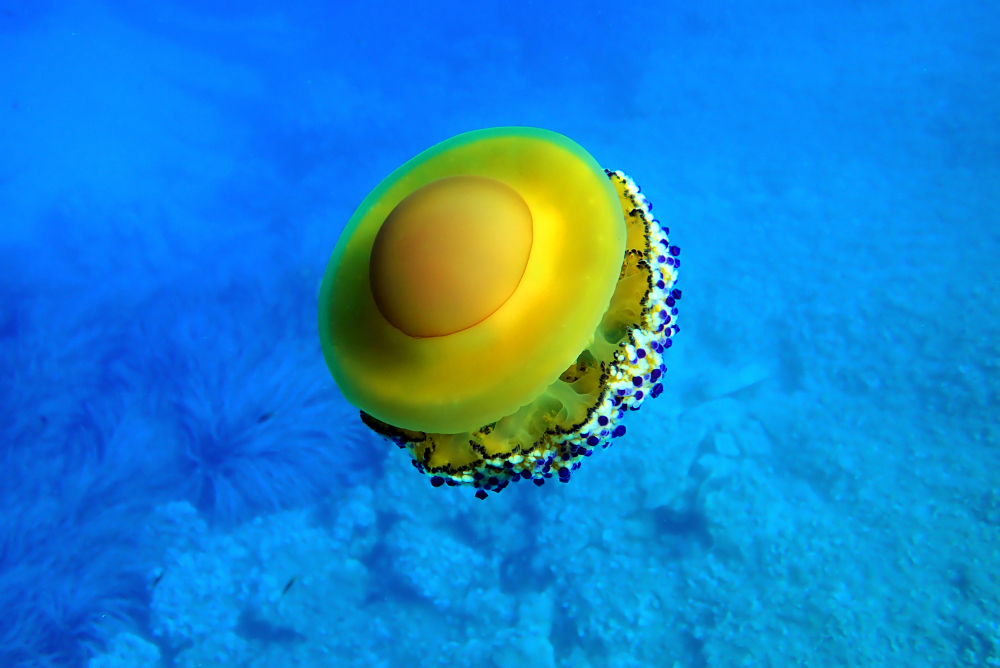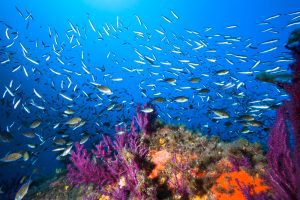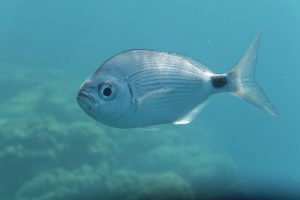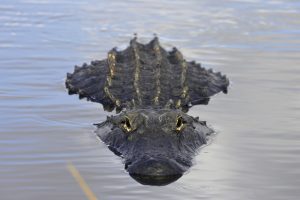The mysterious Mediterranean Sea is filled with diverse marine creatures. In recent years, people have noticed an increasing number of jellyfish blooms in the Mediterranean Sea – but believe it or not, not all jellyfish are harmful. They come in diverse shapes and sizes; some are only 10cm, whereas others are as large as an adult person!
Some jellyfish aren’t that painful and harmful at all – so it’s best to familiarize yourself with the types of jellyfish in the Mediterranean Sea to help you become more cautious. Whether they’re harmless or not, the best preventive measure is to simply avoid them at all costs. In this article, we have listed the 15 types of jellyfish that are found in the Mediterranean Sea.
Table of Contents
1. By-The-Wind Sailor/Purple Sail
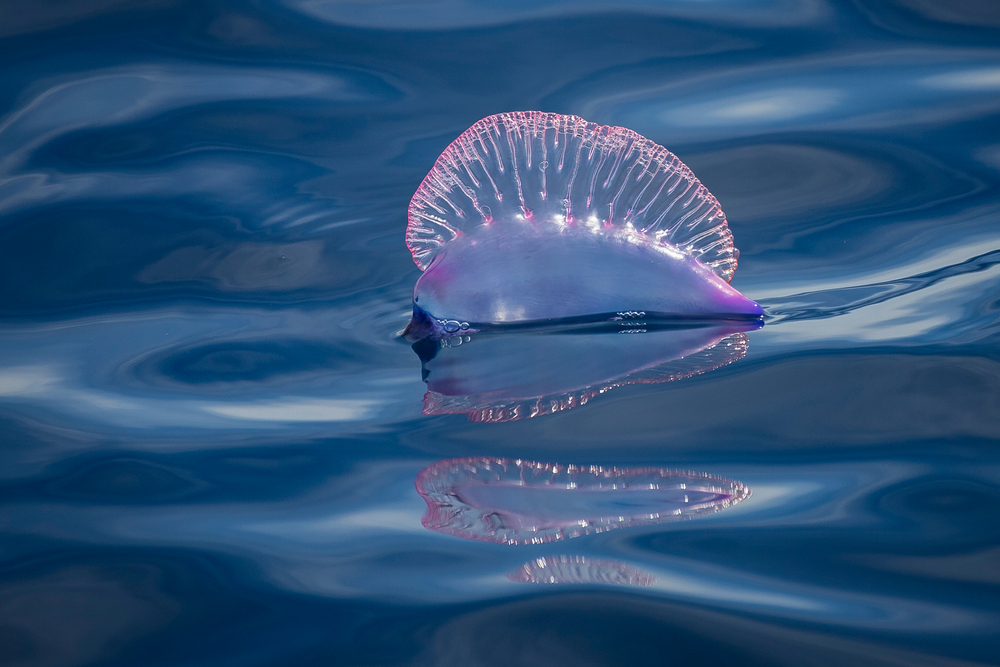
Velella Velella
Sting Level:
A tiny sting that doesn’t hurt much and isn’t harmful to people
Physical Description:
From the name itself, the Purple Sail looks like a sail of a boat. The color of its body is purple to blue and is covered in deep blue circles. It got its blue color because of its prey’s carotenoid pigments that change when eaten.
It has a transparent triangular sail and a transparent flat oval that acts as a float because of its gas-filled pockets. Moreover, the oval float is approximately 6cm to 8cm in diameter.
It ingests its prey with its mouth feeding tube, which is actually surrounded by its reproductive organs.
Behavior:
The Purple Sails drift by the direction of the wind that is caught by their sails. However, strong winds can cause them to spin around and can eventually bring them closer to land. If they stay too long on land, they eventually die and decompose.
During spring plankton blooms, they usually stay at the surface of the ocean to feed.
Habitat:
You’ll find them in warm waters, floating and occupying the surface of the ocean – usually on the rocky or sandy shore. They live partly in and out of the water since their float is above the surface of the water and the polyps below. The only time they stay at the bottom is during the larva stage.
Reproduction:
The Velella Velella reproduces by an asexual process. It produces thousands of tiny medusae that are released from the float. Each medusa is about 1mm in height and width and has zooxanthellae that are used for energy.
It soon develops to sexual maturity in which a female medusa produces an orange egg and the male medusa produces a sperm. When the egg and sperm combine, it results in a planula that soon becomes a conaria, the larva stage.
Food:
Velella Velellas are carnivores that prey on small fish that are caught on the surface of the ocean including fish eggs, copepods, larvae, and euphausiid eggs. They are considered suspension feeders. Plus, they have symbiotic algae and zooxanthellae that also provide nutrition.
2. Flower Hat Jelly
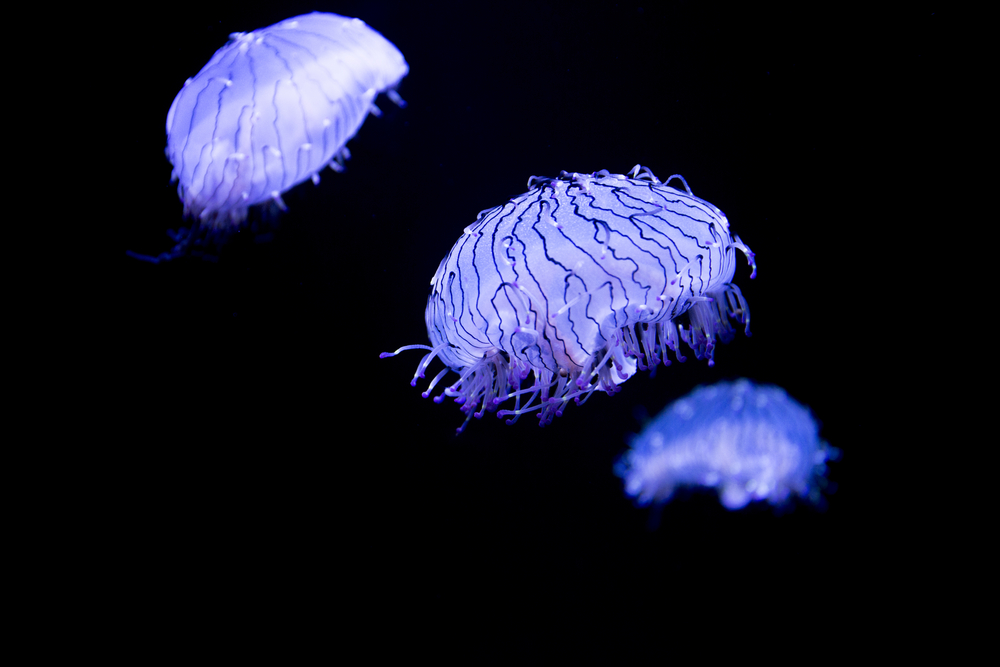
Olindias Formosa
Sting Level:
Mildly painful, and produces a rash.
Physical Description:
The body of the Flower Hat Jelly is shaped like a bell that measures about 15cm in diameter and is translucent, with dark opaque pinstripes. It has lustrous multi-colored tentacles that trail from its bell.
When the tentacles are not used, they coil up to its body – which makes it look short.
Behavior:
A Flower Hat Jelly is nocturnal in nature. It usually stays at the bottom of the sea among rocks and algae during the day. It can survive in a low oxygen environment because the algae produce oxygen inside their body.
At night, they float up to look for food. They sting their prey and grasp at them with their tentacles.
Moreover, their size adapts according to food scarcity. Its body will shrink to reserve energy and require less food, whereas it becomes bigger when there are abundances of prey.
Habitat:
It prefers to reside in kelp and seagrass beds in coastal waters near the seafloor. They are commonly found in the Mediterranean, Southern Japan, Brazil, and Argentina.
Reproduction:
The Flower Hat Jelly begins from an egg, which develops into a larva then a single-tentacled polyp – eventually turning to juvenile, and to the last stage as an adult. They reproduce either asexually or sexually. Similar to the Purple Sail, the male releases sperm, and the female releases an egg to be fertilized that becomes a larva.
Food:
They prey on mostly small fish and sometimes small marine invertebrates. It stings its prey, and the tentacles clench onto it tightly.
3. Fried Egg Jellyfish/Mediterranean Jelly
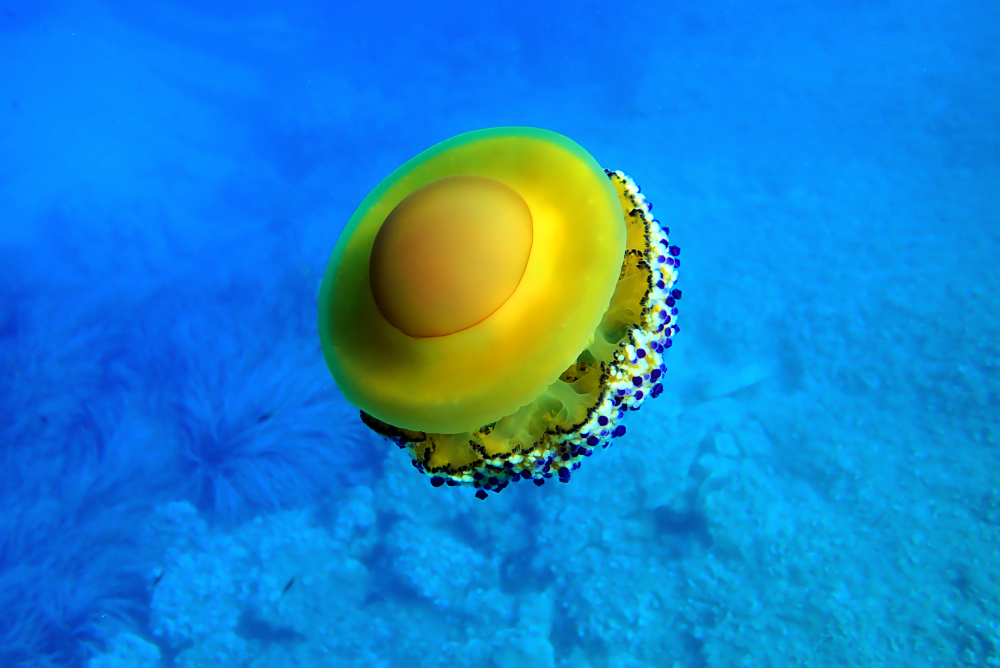
Cotylorhiza Tuberculata
Sting Level:
A weak sting that is not very painful and does not require medical assistance
Physical Description:
The Fried Egg Jellyfish is a medium-sized critter that got its nickname because of its similarities to a fried egg. It has a diameter of about 40cm, with a reddish or yellow flat umbrella top structure that is about 6 to 11in wide.
Beneath the umbrella is where the manubrium is found; this is an external part of the jelly that pulsates and looks like a bouquet of flowers. Its tentacles have blue buttons and are attached to the manubrium.
Behavior:
Fried Egg Jellyfish don’t move around a lot and swim by pulsating their bells. Because of their slow movement, small fish and crabs tend to sit underneath their bell and use it as shelter.
They only live for about six months between summer and winter and can only reproduce in warm waters.
Habitat:
They are abundant in the bays of the Mediterranean sea in summer and autumn. It is common to find them in the coastal waters between 0 to 7m. Moreover, they seem to prefer warmer waters.
Reproduction:
The Fried Egg Jellyfish reproduces sexually during the medusae stage. After fertilization of the egg and sperm, the fertilized egg becomes a larva that settles on the seabed. It eventually becomes small polyps that divide asexually, and drift away and turn into an adult.
Food:
This species feeds on gelatinous zooplankton, small crabs, and other smaller jellyfish.
4. Common Jellyfish/Moon Jelly

Aurelia Aurita
Sting Level:
Not very painful; the venom is harmless to people but can cause irritation and itching
Physical Description:
It is a cup-shaped jelly with pink or blue tones that is about 25cm wide. The umbrella can be about 30 to 40cm and 7.6cm tall with four distinct gonads that are shaped like a horseshoe. It has long tentacles and a manubrium with four long arms.
Behavior:
It swims by pulsating using its coronal muscles and moves horizontally. It spreads its tentacles to make it easier to catch its prey and for defense. A Moon Jellyfish has a sense of taste, smell, and can distinguish between dark and light.
Habitat:
It generally lives in the Mediterranean Sea and the Black Sea, within coastal waters and bays.
Reproduction:
Moon Jelly reproduce through external fertilization, similar to the previously mentioned jellyfish reproduction cycle. The egg and sperm produce a fertilized egg that soon turns into a larva.
The larva then attaches itself to the seafloor, where it develops into an upside-down medusa, otherwise called a polyp. Afterward, the polyp releases clones of itself that develop into a sexually mature jelly.
Food:
The Moon Jellyfish are carnivores that prey on small fish, fish eggs, and zooplankton.
5. Compass Jellyfish

Chrysaora Hysoscella
Sting Level:
Painful; causes a burning sensation that can scar for three weeks.
Physical Description:
The Compass Jellyfish is similar to an umbrella and is usually yellowish to white with some brown lines. It is about 20cm wide with a diameter of 30cm.
Its manubrium has four oral arms that can reach 1m in length, and it has 24 tentacles that are grouped in threes.
Behavior:
The Compass Jellyfish swim when they pump water with their bell. Although they move on their own, they are largely carried by the currents. They’re able to maintain positional equilibrium and perceive orientation.
Additionally, they have pigmented spots that help them perceive light changes.
Habitat:
They are found in thick swarms in coastal waters from 0-30m in the Atlantic and the Mediterranean Sea. They usually live in cold waters between 4°C and 28°C near the surface of the water. However, if the current is too strong, they tend to stay deeper into the ocean around 26.9 m down.
Reproduction:
Compass Jellyfish reproduce via sexual and asexual reproduction. The males release the sperm through their mouth and the females fertilize them internally. Then, the female releases the larvae – which settles as polyps that reproduce asexually by budding off.
Food:
They feed on planktonic animals or other marine invertebrates like phyllopods, copepods, and decapod larvae. To eat their prey, their four oral tentacles sting them and use their tentacles to move them towards their mouth.
6. Upside Down Jellyfish
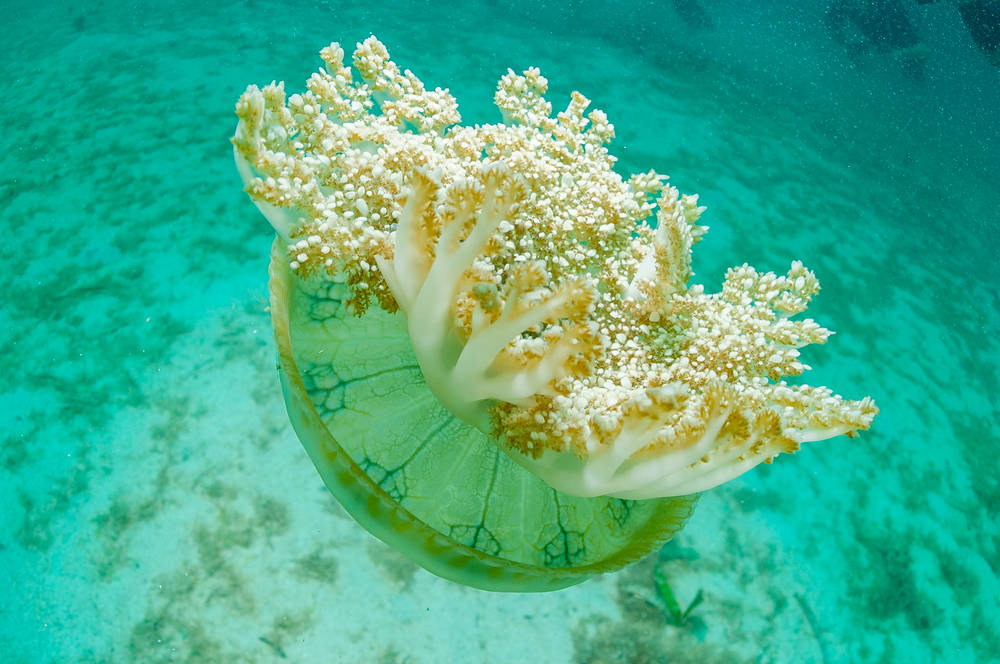
Cassiopea Andromeda
Sting Level:
Painful; can result in a rash and swelling – or vomiting and muscle pains for more severe cases
Physical Description:
The Cassiopea Andromeda looks like an upside-down jellyfish with its mouth lying upward, making it look like a sea anemone.
It measures up to 30cm in diameter and has a yellow to brown bell with white spots. It has brownish arms and frilly tentacles.
Behavior:
Its upside-down position promotes a symbiotic relationship with algae and shrimps. It protects the algae with the nematocyst of the tentacles and the algae provide food. The algae are responsible for the jelly’s brownish color. Similarly, shrimps can safely live in the tentacles which helps remove parasites.
Habitat:
They are commonly found in shallow lagoons, around mangroves, or in the sandy bottom of the Mediterranean Sea.
Reproduction:
It can multiply via asexual and sexual reproduction. It asexually reproduces during the polyp stage by releasing clones of itself, and it sexually reproduces in its medusa stage. The female medusa produces eggs and holds them until a male medusa releases sperm. The female jelly uses its tentacles to collect all the sperm for fertilization.
Food:
This jelly is a carnivore that feeds on drifting zooplankton and small sea animals.
7. Warty Comb Jelly/Sea Walnut
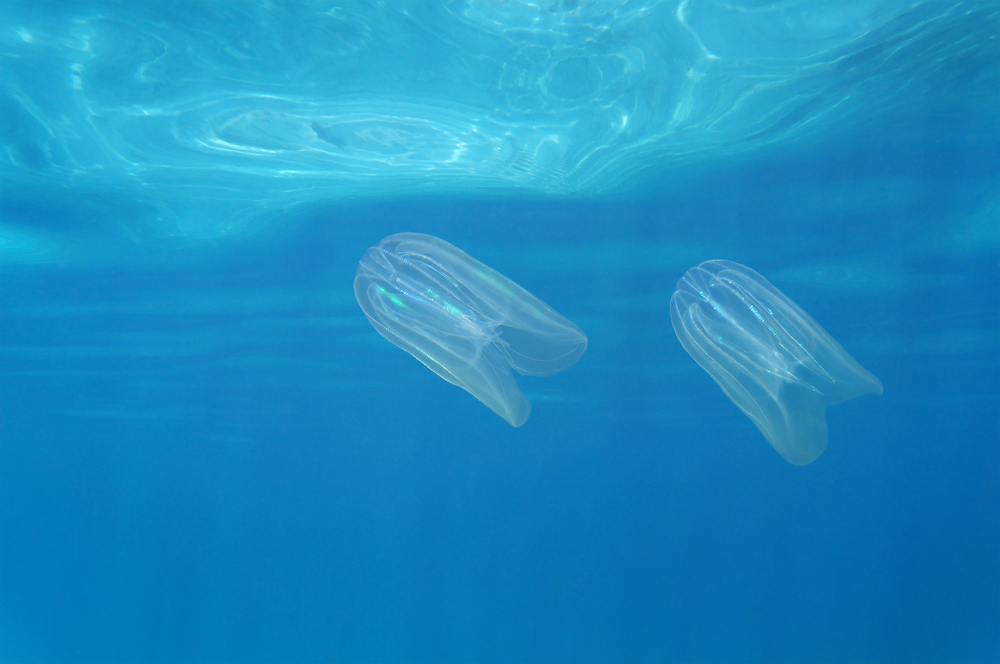
Mnemiopsis Leidyi
Sting Level:
Not a stinger; harmless to people
Physical Description:
This Sea Walnut is a gelatinous organism that doesn’t sting since it doesn’t have stinging cells. Thus, they are harmless to people. It is a translucent oval-shaped lobed jelly that is about 10 to 12cm long and comprises 97% water.
The body has eight ciliated bands in four rows of ciliated combs that allow it to move since it doesn’t pulsate like other jellyfish. When they are disturbed, the ciliated combs glow blue-green.
Behavior:
Their movement depends on the currents of the wind and water. Although they are motionless animals, their cili bands provide some motility by allowing them to remain vertical for feeding and reproduction.
Habitat:
They usually live in coastal seawater in bays and can live in different levels of salinity, from 3% to 39%. Water temperatures of 2°C to 32°C and low oxygen levels are tolerable for them as well.
Reproduction:
Sea Walnuts are hermaphroditic jellies that can fertilize themselves. They carry 150 eggs that are released into the waters along with the sperm. Once the fertilized eggs are in seawater, they become fully-developed larvae in as fast as 20 hours. After they hatch, some may begin producing eggs in just two weeks.
Food:
It is a carnivore that lives by eating eggs, larvae of fish, zooplankton, and other comb jellies.
8. Mediterranean Box Jellyfish

Carybdea Marsupialis
Sting Level:
Painful, but not deadly.
Physical Description:
The Mediterranean Box Jellyfish is a small cubic transparent jellyfish with a diameter of 20 to 40 mm for adults. Its box-shaped bell has tannish or yellowish flecks with stinging cells. Each corner has four elongated tentacles that measure up to 30cm.
Behavior:
It can move by producing rapid pulsations of the bell with a speed as fast as 3-6m in one minute. With its eyes and lenses, it can detect and avoid obstacles in its path. Moreover, it is attracted to light and prefers to stay near the coast at night.
Habitat:
They are normally found in kelp beds near the sea bed and in tropical and subtropical Mediterranean waters.
Reproduction:
They reproduce both sexually and asexually. Once the egg is fertilized, a planula larva develops and becomes a cubopolyp with tentacles – which eventually develops the capacity to reproduce asexually by the process of budding.
The buds detach and further develop within 72 hours. These polyps attach themselves to the substrate and develop 24 tentacles. It detaches from the substrate after one month and further develops the four distinct tentacles of the medusa stage.
Food:
It is a predator that feeds on small fish, invertebrates, crustaceans, and polychaetes.
9. Crown Jellyfish/Cauliflower Jellyfish

Cephea Cephea
Sting Level:
Not harmful to humans.
Physical Description:
It has a bluish bell that looks like a crown and measures about 50 to 60cm, with a total length of 20cm. Its eight arms have 30 filaments with nematocysts for stinging. Plus, they have no heart, brain, or blood – and are made of 95% to 99% water. With its bioluminescence, it has the capacity to make light
Behavior:
They prefer staying in cold waters and only go near the coast to catch prey. When attacked, it distracts its foe with its light. Their overall lifespan only lasts up to six months.
Habitat:
During the day, they are found in deep water where it’s cold, around 24°C to 28°C and 3,000 ft deep. At night, they stay near the surface of the water to catch their prey.
Reproduction:
Crown Jellyfish reproduce both asexually and sexually. In sexual reproduction, the medusa or adult stage reproduces by releasing eggs and fertilizing them with sperm.
Asexual reproduction happens when a planula develops, during the budding process.
Food:
They feed on zooplankton, algae, hatched baby brine shrimp, coral reef food, and invertebrate eggs.
10. Barrel Jellyfish/Shiff Arms Jellyfish
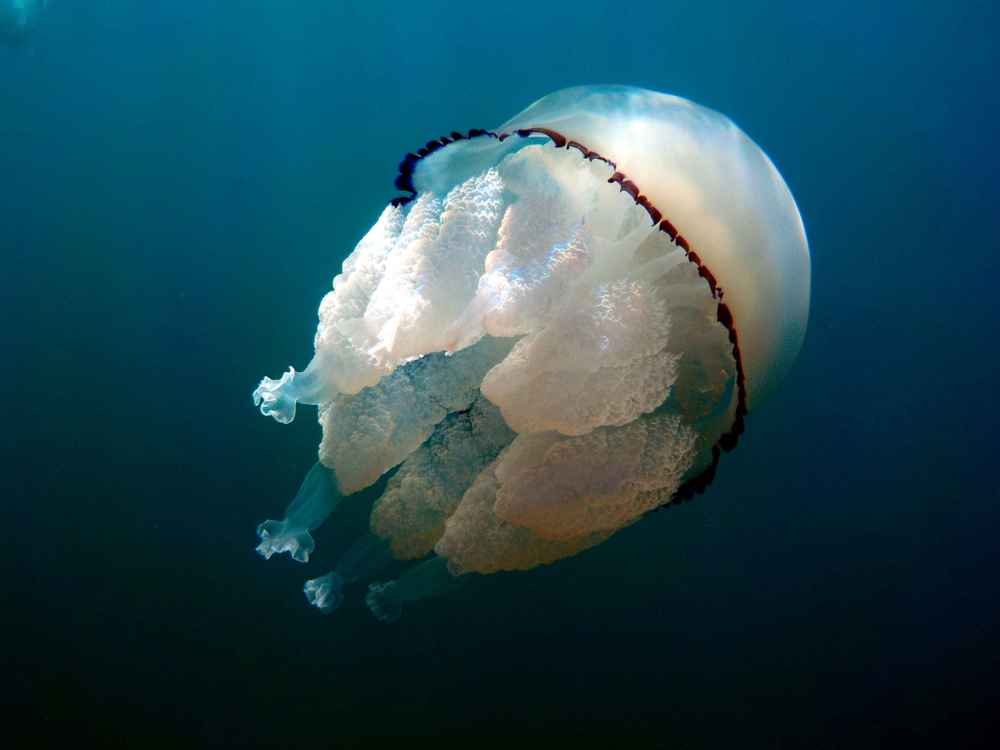
Rhizostoma Pulmo
Sting Level:
Mild sting, but can cause rashes.
Physical Description:
It is easily distinguishable, with its blue ring lining in its white umbrella. They average up to 2ft wide with a diameter of 60cm, making them large enough for small fish and crabs to use as shelter. They look like a white cauliflower with eight tentacles and weighing about 10kg.
Behavior:
They are slow-moving jellies with powerful pulsations.
Habitat:
It is abundant in coasts and deeper waters in the winter season.
Reproduction:
In sexual reproduction, the male and female jelly release egg and sperm cells that need to be fertilized. After fertilization, it becomes a polyp that anchors on the seafloor and clones itself for asexual reproduction. A fully grown adult is called a medusa, which spawns every day and at only a specific time of day.
Food:
They usually feed on tiny plankton with many small mouths (they don’t have a single mouth).
11. Purple-Striped Jellyfish/ Pink Jellyfish/Mauve Stinger
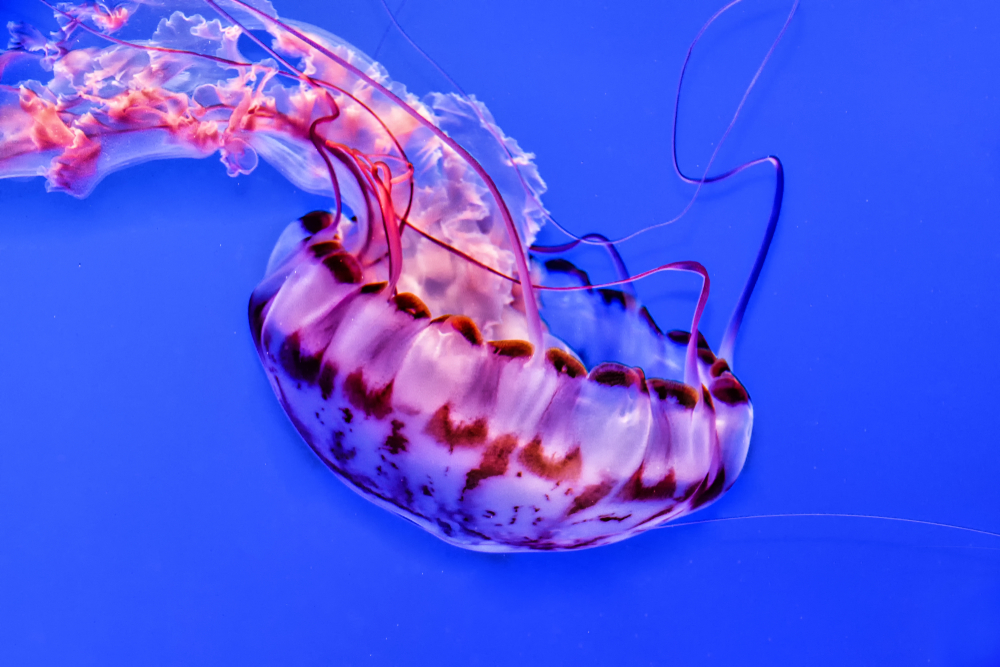
Pelagia Noctiluca
Sting Level:
Very painful and dangerous; can leave scars.
Physical Description:
Pink Jellyfish are pink or purple in color and are small and transparent with only 6-10cm in diameter. They have eight tentacles, four oral arms, and gastric pouches that are covered in nematocysts, making them one of the most venomous jellyfish.
Behavior:
This jellyfish produces light when disturbed, which is also believed to be another way of communication. It has the ability to detect light with its ocelli eyes.
Habitat:
They are commonly found in swarms in warm, temperate Mediterranean waters in summer. They actively swim between 12 to 30m near the coastal water.
Reproduction:
Reproduction occurs more commonly from April-December when the ephyra grows up to 7mm in diameter. During the winter months, their development slows down with the cold water temperatures.
The eggs are laid and turn into a planula after three days. After becoming a planula, it turns into an ephyra and grows into a young adult in a month.
Food:
They prey on eggs and larvae of fish.
12. Portuguese Man o’War
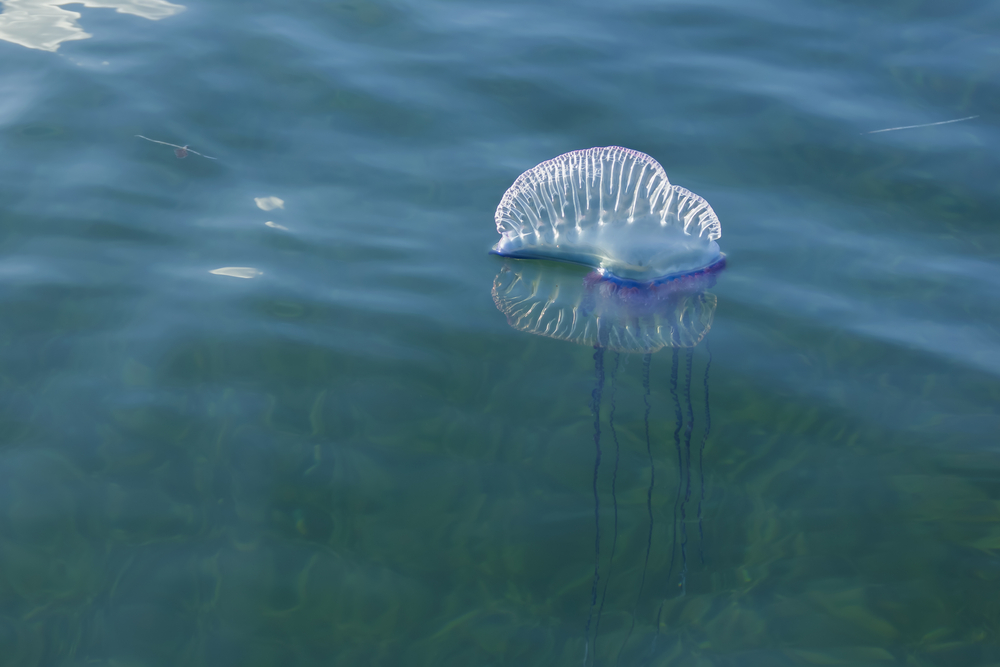
Physalia Physalis
Sting Level:
Very painful, and extremely dangerous
Physical Description:
This cold-water creature is up to 2m long and has tentacles of up to 50m. It is distinguishable by its balloon-like float that is either blue or purple. It isn’t considered a jellyfish, but a siphonophore that is a colony of polyps and medusae.
Siphonophores are groups of organisms that live and work together and act as one animal. It has a mouth to ingest its prey and polyps that contain a powerful venom for stinging.
Behavior:
With its air sacs or float, they only move and drift according to the currents of the wind and water. Its float has the ability to deflate the air and go below the surface of the water when there are dangers above.
Habitat:
It is common to find them floating in warm waters in tropical and subtropical areas.
Reproduction:
It is a wonder how they multiply since they are different organisms living together. However, Portuguese Man O’ War can be either male or female and they reproduce sexually and asexually.
When both the egg and sperm meet for fertilization, it forms a gonozooid, which begins its budding process of asexual reproduction. The gonozooids bud off the pneumatophores, the dactylzooids, and the gastrozooids, which then form the entire Portuguese man o’ war where they live together and feed each other.
Food:
They feed mostly on small and young adult fish. Additionally, they also prey on crustaceans, shrimp, and plankton.
13. Nomad Jellyfish
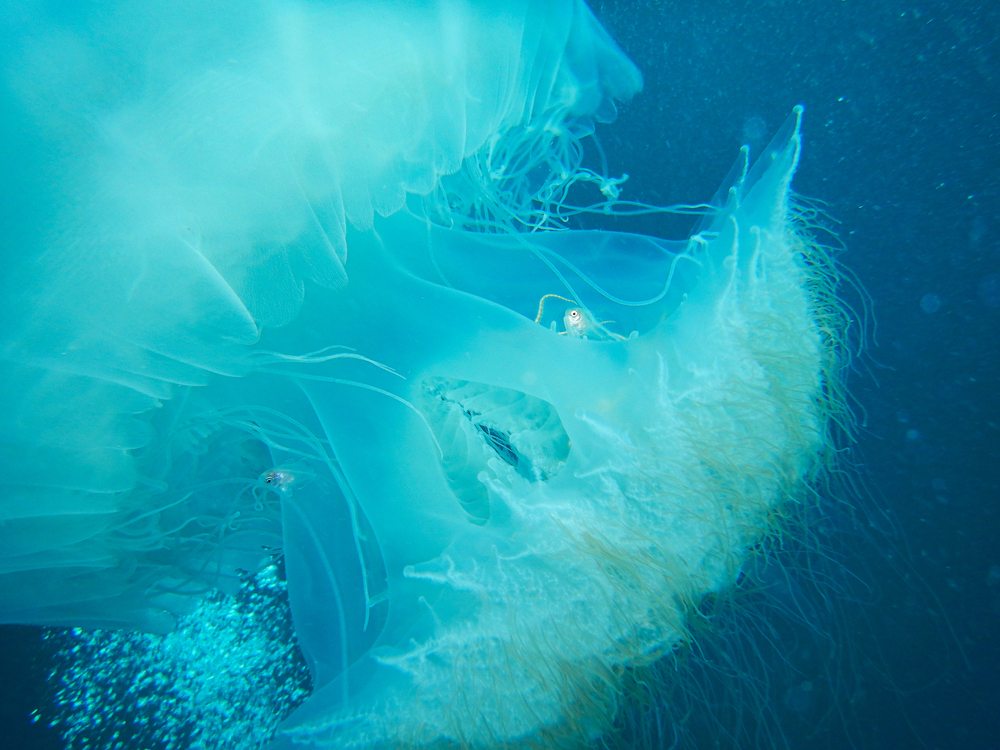
Rhopilema Nomadica
Sting Level:
Very painful.
Physical Description:
They commonly measure about 60cm but can be as big as 80cm in diameter and weigh as heavy as 10kg. It is a translucent jelly with a light blue to white color. Its bell is round like a balloon with tiny strands of white tentacles.
Behavior:
Many studies have shown that they swim by paddling their bell and moving against the current. They have shown swimming capabilities that make them swim faster against the current rather than swimming with it.
Habitat:
They have the capacity to tolerate water temperatures from 16 to 31°C in the Eastern Mediterranean.
Reproduction:
The spawning of these jellies happens in summer. In sexual reproduction, fertilization takes place externally. Once the egg is fertilized, the planulae grow in a few hours. The planulae settle in the sea bed within three to fours days and eventually develop into polyps in three weeks.
In the polyp stage, asexual reproduction begins through podocytes formation. The polyps turn from polydisc strobilate to ephyrae to a young medusa. A young medusa is between 7 to 10mm in diameter.
Food:
They live by eating plankton for their nutritional needs.
14. Cigar Jellyfish
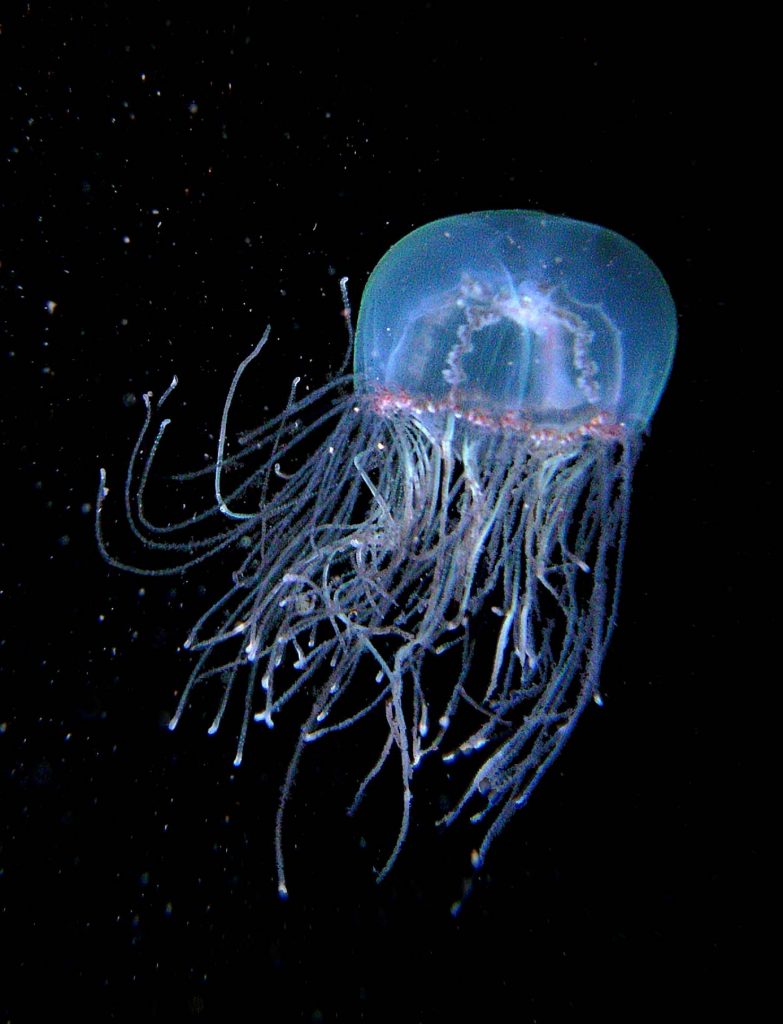
Olindias Phosphorica
Sting Level:
A serious stinger that is quite painful. When a person is stung by its tentacles, it shows zig-zag lines on the skin.
Physical Description:
Cigar Jellyfish have a dome-shaped transparent bell with many blue or dark red tentacles that can reach up to 10m in length. The umbrella is sometimes a translucent flat disc during the day but becomes blue-green at night with its bioluminescence.
Moreover, it has four canals and several centripetal canals.
Behavior:
It reduces or increases size depending on food availability. When there is food scarcity, it reduces its size to decrease need, whereas the abundance of food makes its size bigger.
Cigar Jellyfish got its name from its cigar-shaped appearance when rolling its body. When the jelly sleeps, it rolls its body and retracts its tentacles.
Habitat:
They are commonly seen on the sea bed or near the surface of the water in the Atlantic and the Mediterranean Sea.
Reproduction:
It is a species of hydrozoa, which means it has both a polypoid and a medusoid stage. Once the egg is fertilized, it grows into planula to polyp and then an adult medusa. During feeding time, the body unrolls itself and the tentacles extend to find its prey.
Food:
Zooplanktons are their food source.
15. White-Spotted Jellyfish

Phyllorhiza Punctata
Sting Level:
A mild venom that is not dangerous.
Physical Description:
The bluish-brown bell of White-spotted Jellyfish can reach up to 50cm in diameter. It has white spots and eight thick oral arms with a ribbon-like translucent appendage.
Behavior:
Although it has tentacles with venom, they don’t use them to sting their prey. Instead, they are filter feeders that clean the water up to 50 cubic meters daily since they feed on zooplankton.
Habitat:
They prefer nearshore waters and murky waters near the harbors and estuaries.
Reproduction:
White-spotted Jellyfish have two stages of their life cycle: medusa stage and polyp stage. The medusa stage involves egg fertilization with sperm. The female collects all the sperm into her mouth and fertilizes it internally.
Once fertilized, it will develop into larvae and settle on the seabed to grow. The second stage, the polyp stage, involves cloning itself and reproducing asexually.
Food:
Its main source of nutrients is zooplankton.
If You Get Stung by a Jellyfish, What Do You Do?
Make sure you don’t spread or aggravate the effects of the nematocyst discharge. If the tentacles are still attached to your skin, do not remove them with your hand, but rinse them out with seawater instead.
Touching it again will only add more burns and damage to your skin.
Additionally, keep in mind that nematocysts react to osmotic changes, so rinsing it with fresh water or alcohol can only worsen the effects. Rubbing and scratching the burn – will also cause more reaction and pain.
In case you can’t remove the tentacles with seawater, try using thin objects like credit cards, tweezers, or the back end of a knife.
Once removed, you can help neutralize the effects of the venom by pouring vinegar as a first-aid treatment. This is most commonly done only to mild stings with symptoms that don’t require hospitalization. However, if you are stung by dangerous classifications of jellyfish and experience some symptoms like vomiting, nausea, diarrhea, shock, and fever, it is a must to seek medical assistance right away.
One of the many ways to ease the pain is heating seawater at 43 to 45°C and submerging the affected area in the heated seawater for a maximum of 40 minutes.
The Bottom Line
Before swimming in the sea, keep an eye out for any possible critters floating around. If you spot a jellyfish, there are most likely more of them, as they usually come in swarms – so don’t get in the water, and warn the others. Most importantly, don’t try to touch them – as some jellyfish are created with venomous body parts, not only the tentacles.
Going on a vacation to the beach? Avoid jellyfish stings by doing your research about that beach. Only choose guarded beaches where lifeguards are always on the lookout for possible jellyfish swarms.
Some beaches even have signs put up if jellyfish are floating on the shore. Plus, you can take note of the common specific times of the day or season where jellyfish are rampant.
Always bring vinegar and tweezers with you for first aid in case you get stung.
These jellyfish don’t usually bother anyone unless they’re disturbed – so if you see a gelatin-like blob that jiggles and floats, it’s best to watch them from afar and refrain from swimming in the area.
It’s common knowledge that their tentacles are harmful to people. The sting level can vary from mild to severe and has different levels of effects. It’s important to understand that their tentacles are made up of thousands of tiny stingers. One sting is equivalent to thousands of tiny stingers that release venom to the body.
Let’s compare it to the bite of an ant. It’s not just one single bite, but a colony of ants that bit you and left its poison to your body. If you’re unlucky, and a dangerous jellyfish stung you, it can make you sick very quickly and can cause severe effects.

